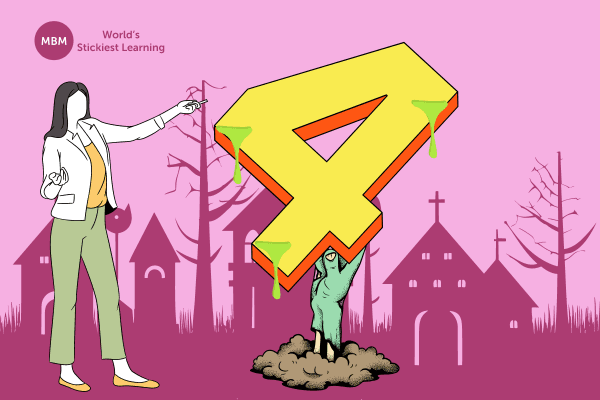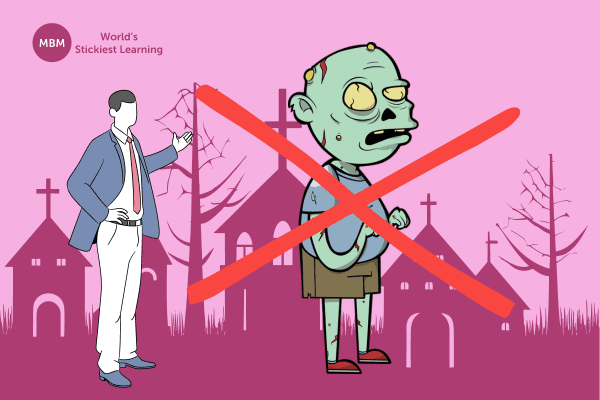Time is Up for Zombie Leadership
This topic is such an important one for us to address nowadays. Old-school ideas of the ultimate power of leaders have no place in today’s organisations, team dynamics, or even governments (no fear, this is NOT a political article). Zombie leadership creates a toxic environment for everyone involved. In fact, it stifles collaboration, restricts growth and development, and keeps teams stuck in authoritarian structures.
As we proceed through the article, we will cover:
- What is zombie leadership all about?
- The 4 key characteristics to know
- Essential steps for moving forward and making change
- Potential barriers that prevent forward movement and hold individuals and groups from progressing
By the end of the article, we will cover the essentials you need to understand this important topic, identify where changes are needed, and outline the steps to improve things.

What is Zombie Leadership?
As we know, leadership is a complicated and diverse skill set to learn. So, when we talk about “zombie leadership”, it adds a new layer of complications to the necessary role of leaders in any industry today.
Professor Alex Haslam, from the School of Psychology UQ, led the study at the University of Queensland to better understand this concept of zombie leadership. These leadership ideas have been repeatedly debunked, however, they won’t go away. The time has come for us to stand up and ensure these old-school ideas get removed from our organisations.
Professor Haslam is quoted as saying “Zombie leadership is poisonous for organisations and society,”, which is a red flag for any company.
There are 4 key characteristics that Haslam and his co-authors identified while analysing this concept of zombie leadership. They are:
- Only leaders can lead
- Leaders have qualities that set them apart
- Group success should be attributed to leaders
- History is ultimately the story of great leaders
From experience, and having worked alongside many different types of leaders, I fully understand the need for change. Unfortunately, I have first-hand experience of the toxic environment that bad, old-school leaders create. Unbelievably, these zombie leaders exist across the board and are difficult to remove.
So, based on the characteristics above, can you already picture some real-life examples of zombie leaders? I know I can!
4 Key Characteristics of Zombie Leadership

Here, let’s look closer at the 4 key characteristics of zombie leadership. It’s important to know these to better understand how we can identify them in ourselves and others. Also, we must know the negativity these characteristics bring to the team dynamic. So, let’s get started.
#1: “Only Leaders Can Lead”
Wow, I didn’t realise this old-school concept still exists in today’s workplace. There are many examples of where employees throughout the company, at all levels of the organisation, display important leadership qualities and skills. Simple examples include when they:
- Communicate effectively
- Develop others
- Solve problems successfully
- Make effective decisions
- Display proper customer service focus
- Think creatively
- Use proper interpersonal skills
- Practice effective time management skills
As such, try not to get yourself caught up in the idea that only people with leadership roles or titles lead. Instead, ensure everyone displaying leadership qualities is recognised. Also, create opportunities where team members can grow and develop leadership skills through training and on-the-job experience.
Sticky Learning ® is 7 times more effective than 1-day training courses. Plus, you will get a Chain of Evidence proving your Return on Investment. Discover soft skills training that changes behaviours long term.

#2: “Leaders Have Qualities That Set Them Apart”
Anyone who has completed leadership training knows that leadership skills can be learned. Otherwise, trainers around the world would potentially lose their jobs. Zombie leadership suggests that leaders are unique in their skill sets. Realistically, the qualities we need to be successful leaders are skills we can learn over time. Some come naturally to us. However, others are developed through training and experience.
This characteristic suggests that all leaders are from a special, elite group and it fails to recognise the capabilities of others. This is very limiting in terms of appreciation and future development opportunities in the company. What we see them displaying include:
- Resist growing and developing others
- Retain complete control over every aspect of the company and operations
- Micro-manage others
- Avoid Including others in decision-making
- Promote their individual contributions rather than the group effort
#3: “Group Success Should Be Attributed to Leaders”
In this case, zombie leadership indicates that all success is attributed to the role of the leader. It fails to consider the efforts and contributions of everyone else in the team. This is an unrealistic way of looking at the big picture. In fact, without the rest of the team, leaders are limited in what they can achieve. Leaders on their own:
- Are limited to the amount of work they can cover alone
- Miss the creative thinking and suggestions of their team
- Fail to meet deadlines and achieve all company targets without a group effort
- Lack the skills, knowledge and experience of their team to complete tasks and projects
The leader’s role is an important one, however, without the team supporting them they achieve a lot less in terms of success. As they say, “No man is an island”, and that applies to leaders as well.
#4: “History is Ultimately the Story of Great Leaders”
History reflects the contributions of everyone involved in the event. However, it tends to be the names of leaders who are remembered for the events that occur. That is far from saying that only leaders contribute to our history. Instead, history is the story of everyone.
So create history that involves everyone. Avoid excluding key players when planning long-term goals for your team. In this way, you ensure the inclusion of all players and contributors. Also, support everyone in such a way that they feel included and appreciated. The history of your company, their achievements, and its successes are attributed to everyone involved, not just your leaders.
How to Make the Necessary Changes

We need to remove zombie leadership from our organisations. There are several ways to achieve this with different steps we apply. Here are some examples.
1: Respect the Contribution of Everyone
So, team success is NOT just linked to leadership. That is one element of the overall results. Zombie leadership makes that mistake. In fact, contributions come from every team member. So, we should:
- Delegate effectively
- Assign tasks based on strengths and capabilities
- Recognise the efforts of all team members
- Praise and appreciate the contributions everyone displays
- Also, ensure recognition programmes are in place to reward efforts
Here, we create engagement. Additionally, we see appreciation which motivates team members to contribute more every day.
2: Leadership Can Be Learned
Remember, leadership skills are a set of qualities that we can learn through training and on-the-job experiences. So create multiple opportunities across the organisation to ensure this happens.
- First, develop leadership programmes, either internally or by using external facilitators
- Next, create personal development plans that allow team members to prepare in advance for leadership roles
- Also, promote employees based on capabilities and willingness to grow
Ideally, there are training programmes in place that allow for growth and development within the organisation. Time, effort and financial investment are all needed for this to happen.
3: Develop Leadership Talent Within the Team
Next, conduct proper performance reviews to identify talent in the team. Also, apply the above-mentioned steps, ensuring that learning and development opportunities exist. As a result of the conducted performance reviews, create a training needs analysis to highlight key learning needs. Use some of the following steps to proceed.
- First, use the training needs analysis to highlight strengths and areas of improvement
- Now, create a training matrix to track learning and development needs in the team
- Next, schedule training for different leadership skills as needed
- Also, evaluate the effectiveness of the training through assessments, practical applications, and tests
- Finally, review career opportunities for employees
Ideally, leadership development contributes towards increased motivation, better engagement, and longevity in the company. Either, hire an internal trainer who can conduct the necessary courses, or, utilise external companies to provide the same.
4: Great Leaders Are Developed Not Born
As we mentioned in previous sections above, leaders are developed. While some leaders have natural talents and skills they display, most develop those skills over time and experience. Many learn from mentors and are inspired by them during their careers. Others work their way through the ranks of the company to grow and develop through the different stages of their career.
Either way, or with the combination of both, leaders use all their knowledge, skills, and experience to further inspire others. Great leaders create future leaders. Also, they inspire others to do and be more. They:
- Lead by example
- Encourage others to grow and develop
- Promote internal opportunities in the company for others to grow
- Communicate openly and honestly
- Involve others in group tasks and activities
- Recognise and reward the contributions of others
As a leader, recognise the importance of developing and growing great talent in your team.
5: Create Great Teams That Achieve Success
Successful leaders appreciate and grow strong teams. They develop the skills and knowledge needed for success. We achieve this in a number of ways.
- First, select strong individuals at recruitment who add value to your team
- Also, develop effective onboarding so new joiners successfully immerse in the team
- Next, identify the strengths of each team member
- From there, match tasks to the strengths of each person
- Now, encourage effective teamwork across the team
- Also, promote peer recognition and appreciation to increase motivation
- Then, celebrate success as a group when you achieve targets
Here, these steps create great possibilities for developing strong, effective teams. As leaders, ensure you celebrate and reward your teams. Also, encourage team brainstorming for increased creative thinking and problem-solving.
Barriers That Prevent Zombie Leadership From Disappearing

Zombie leadership creates toxic environments and staff dissatisfaction. It is baffling how it still exists in today’s workplace. There are several reasons zombie leadership still exists and why some leaders simply can’t move on. We see that zombie leaders:
- Fear they will lose their power and control
- Resist acknowledging the capabilities of others
- Are narcissistic, believing they are more special than others
- Need the feeling of authority over others to feel important
- Fail to understand the importance teamwork plays in achieving results
- Believe they are part of an elite group that others don’t belong to
Unfortunately, these barriers create resistance to moving on from the zombie leadership mentality. Ideally, strong, effective leaders know the right way forward and make the changes needed to improve their approach. However, use the steps explained above to overcome several of these barriers. Also, encourage others to do the same. Leaders need to take responsibility for making the necessary changes.
Examples of Zombie Leaders
This is a tough one to discuss without seeming to target individuals. However, through their actions, behaviours, and rhetoric, they show us their “zombie leader” qualities. We do not use names; instead, we focus on roles that are more likely to exhibit zombie leadership qualities.
1- Company CEO/Senior Leaders
Obviously, this doesn’t apply to ALL CEOs or senior leaders. Instead, it specifically applies to those who have the irrational notion that they have certain entitlements. This means they risk joining the zombie leadership elites. This is a big mistake for any CEO or senior leader to make. It alienates them from their team and potentially shows their narcissistic side.
2- Government Officials (past, present and potential future candidates)
Throughout history, and in today’s real-world situations, there are local and national-level government officials who believe that they are above the law. Remember, as per the zombie leadership characteristics, leaders are the “be-all and end-all”. In reality, we know this is not the case. In fact, as leaders, holding official roles and positions, they should be the ultimate example of what we do and how we do it.
Unfortunately, there are too many examples under this heading to name. Every company, and every local area, can fall foul of this type of leadership example where “zombie leaders” rule without proper restrictions and accountability for their actions.
3- Celebrities
So many different celebrities, from pop stars to actors, to sports personalities, have followers in person and online. If they display the 4 characteristics mentioned earlier in the article, they run the risk of falling into the zombie leadership void. They have a lot of influence over their followers. Therefore, they need to act and communicate in ways that promote more equality and acceptance, rather than self-focus.
To Wrap Up

Having worked with leaders in the past live by the 4 zombie leadership characteristics I have seen first-hand how this mentality negatively impacts the organisation. Every company needs to spend time analysing its leadership roles and characteristics to remove any toxic zombie leadership approaches it finds.
Zombie leadership has no place in any organisation nowadays. Instead, we should:
- Use different leadership styles in different situations
- Appreciate and recognise team efforts
- Avoid focusing on “me” and instead focus on “us”
- Encourage growth and development opportunities
- Create a healthy work environment
- Promote teamwork and collaboration
- Celebrate success as a group
- Move away from old-school, toxic leadership practices
Check the different resources available with MBM to develop leadership skills in your company. We have amazing resources, such as our coaching cards, additional blog articles about leadership, and training programmes that can meet your needs. There is something for everyone when it comes to leadership development so take a look or get in touch. We’re happy to discuss tailor-made programmes for you and your organisation.




